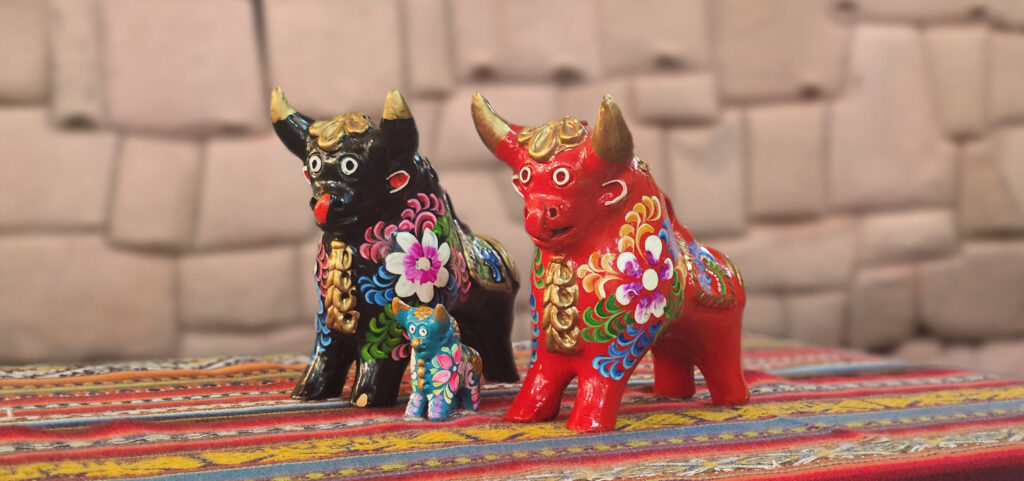In your travel to Peru, especially in Andean areas such as Cusco, Puno, and Arequipa, you can see on the roofs of Andean houses two tiny two-horned curious silhouettes protercting it. However, this is not just an ornament; it is much more than that: It’s an ancient totemic symbol that keeps families and people for generations.
We’re talking about “Los Toritos de Pucara,” an important part of Andean culture with a deep meaning, especially for Andean people. But why are they so special and important? Stay with us to find out
Origin and Legend
El Torito de Pucará tells an intriguing story. In a lovely tiny village called Pucará, hidden in the Puno area, the people faced a severe drought that threatened their lives. As the water wells ran empty, an indigenous farmer decided to ask for assistance from Pachakamaq, the god of creation.
He courageously guided a bull to the top of Pucará rock as an offering, despite the bull’s reluctance. In an unexpected turn of events, as the bull rubbed against the rock, its horn formed a small opening, allowing water to pour from the stone.
This miracle gave a break to everyone, who felt overwhelmed with thanks and amazement. They began to venerate the bull, making it an important element of their local traditions, particularly during cattle branding ceremonies.
Inspired by this wonderful fable, Pucará artists began making amazing ceramic bull sculptures. These figures quickly became beloved icons, placed on rooftops to defend homes and remember every one of that magical day.
Symbolysm and Tradition
The Pucará bull is a totemic symbol in Andean culture, used in rituals for its deep aesthetic and spiritual significance. Ceremonial liquids like chicha and water poured into the bull symbolize life and fertility. The bull’s iconography includes a hole at the sacrum, representing water and feminine fertility.
The handle connecting to this hole symbolizes sexual energy and the union of man and woman, creating new life. Spiral designs on the bull embody the belief in life’s cyclical nature, where what one gives returns.
The bull’s eyes mean mankind’s need for constant self-awareness. Another key element of the Pucará bull is Andean duality, with paired bulls placed on rooftops to symbolize the balance of positive and negative energies, bringing protection and happiness to families. Its colors carry symbolic meanings:
White represents purity and protection.
Blue Bull promotes serenity, harmony, and loyalty, nurturing a strong bond between partners.
Cream Bull radiates optimism and fosters family happiness and well-being.
The green bull represents fertility and balance, encouraging harmony in life.
Black or purple bulls embody nobility, wisdom, creativity, and spirituality, inspiring greatness in the couple.
Yellow Pucará bull shines with energy and brings good luck to its owner, helping them thrive.
Andean duality is an important aspect of the Pucará bull, with twin bulls placed on rooftops to represent the balance of positive and negative forces, which makes it a symbol of protection that brings prosperity to families.
Making Process
Creating a Torito de Pucará is a wonderful journey. It needs the right materials, a sprinkle of creativity, a dash of determination, and a touch of faith. Puno people believe in more than just crafting these charming protective figures. It is about being inspired and respecting each piece.
The process starts with shaping the Torito in a plaster mold, where care and attention to detail are key. After the form is complete, you can add beautiful decorations, and then it’s time to let the figure dry. Once the mold is completely dry, it goes into an artisan kiln, usually powered by gas.
It is fired for about six hours until it reaches the perfect stage. After coming out of the kiln, the Torito is painted and glazed. If it meets the artist’s standards, it will be fired once more to finish the process beautifully.
Pucara Bull in the Present Day
These little bulls have become an important part of Peruvian culture, thanks to their fascinating story, so they become a beloved symbol of Peruvian culture. You can find them on Andean rooftops and in homes around the world, adding a splash of color and artistry.
These bright, detailed figures not only protect but also highlight the incredible talent of Peruvian artists. Beyond their beauty, Toritos represent hope, abundance, and a deep connection to Andean traditions. For those visiting Peru, a Torito de Pucará is more than just a decorative piece; it carries a rich history and is part of the Andean Cosmovision.
Picture taken by Yarpapayachin.
Should you take a Torito home? Definitely! This delightful bull is more than a simple souvenir. It represents Peru’s vibrant culture and the special relationship between people, nature, and the divine. Owning a Torito serves as a meaningful reminder of Peru’s lively traditions, and is a personalized gift depending on the color you prefer.
At Viagens Machu Picchu, every trip to Peru offers a chance to connect with its rich history, legends, and living cultures. If you’re curious about our tour packages or want to plan a visit to Puno or the Andes, don’t hesitate to get in touch.
We’re excited to help you create a memorable experience filled with unique insights and cherished memories. Contact us today, and let’s start exploring the wonders of Peru together!
Viagens Machu Picchu, journeys that inspire, moments that last.

